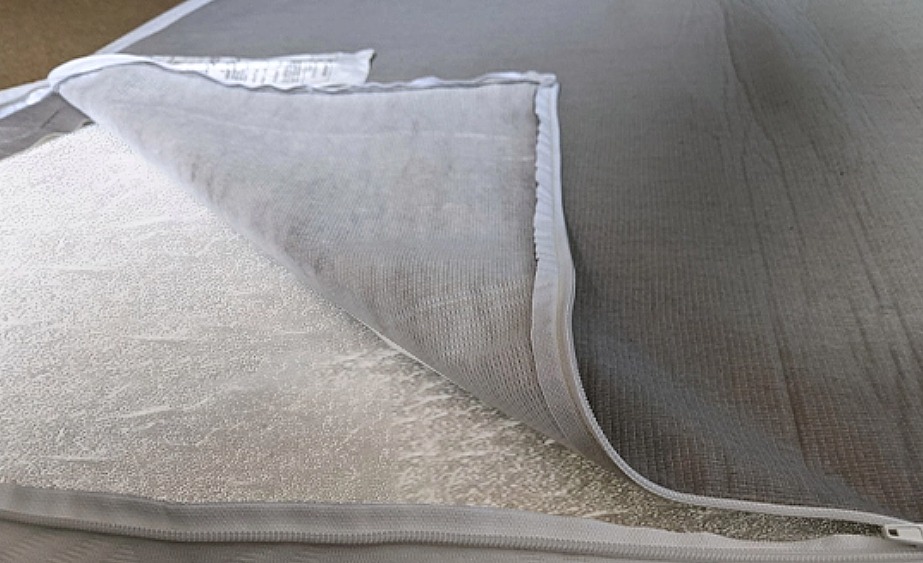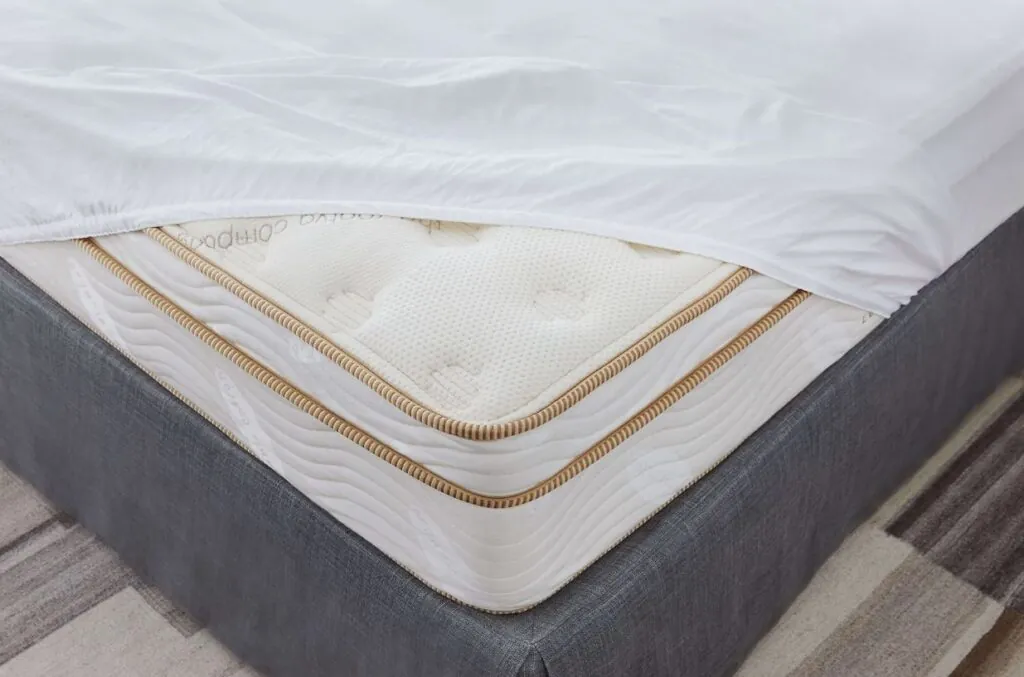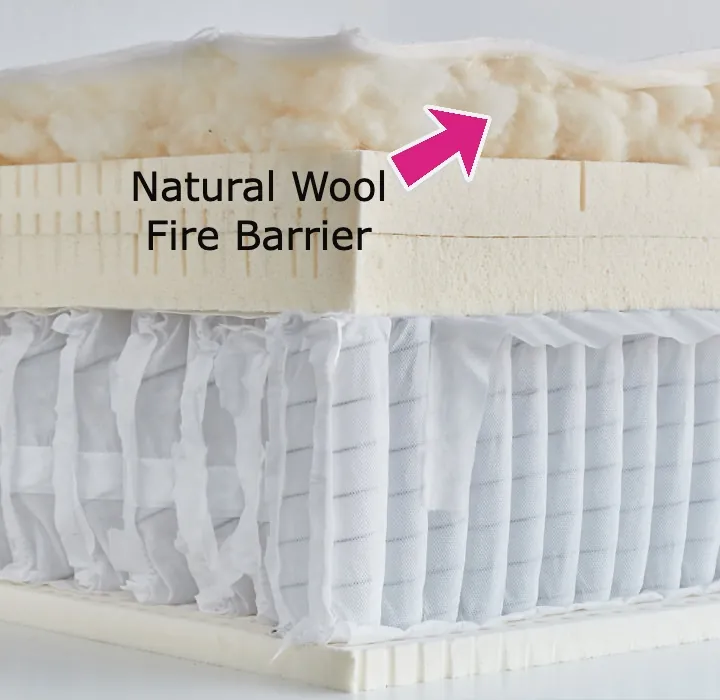Is Fiberglass Inside Your Mattress? What You Need To Know, According To An Expert
Fiberglass is used in mattresses as a fire retardant because it has properties that help reduce the flammability of the materials used in mattress construction. Fire safety regulations require mattresses to meet certain flammability standards to ensure consumer safety. Manufacturers of most bed in a box mattresses use what are called “fire socks” or a barrier fabric which is sewn into the outer covering of a mattress.

Fiberglass inside a Zinus bed in a box mattress
In 2021, a class action lawsuit was filed against a bed in a box company called Zinus, which was found to be using fiberglass inside of a zippered covering. Once consumers opened the cover to attempt to wash it, fiberglass became airborne, caused respiratory distress, irritation, and health concerns.
Because of its resistance to high heat, using fiber glass allows the mattress to pass the burn test, where prototype samples are physically tested using a blowtorch placed in direct proximity of the mattress.
If the contents do not ignite within a certain amount of time, the mattress passes the burn test, a federal flammability certificate is provided and the mattress can be sold on the open market exactly as it was presented for testing. These laws are referred to within the mattress industry as FR1633 laws.
What Makes Fiberglass Such A Hazard, Especially Inside A Mattress?
Fiberglass is a material made from fine fibers of glass. It is used in mattresses in the form of a non-woven fabric or as a layer or barrier within the mattress. When exposed to heat or flames, fiberglass can help prevent the rapid spread of fire by resisting ignition and reducing the combustibility of the mattress materials.
By incorporating fiberglass as a fire retardant, mattress manufacturers aim to enhance the safety of their products and comply with fire safety regulations. However, it’s important to note that proper handling and containment of fiberglass within the mattress are crucial to prevent the release of fiberglass particles, which can pose potential health risks if they become airborne or come into contact with the skin.
When fiberglass is exposed in a confined environment, it can easily be spread like fine dust, and to completely remove it from a home, for example, can cost up to $15,000. It can cause serious health hazards especially when continuous exposure occurs.
When fiberglass particles are inhaled, they can cause irritation and various health problems. The severity of these health issues may depend on the duration and intensity of exposure, as well as individual sensitivity.
Here are some potential medical problems that can occur when you breathe in fiberglass:, especially over prolonged periods of time:
- Respiratory Irritation: Inhaling fiberglass particles can irritate the respiratory system, leading to symptoms such as coughing, wheezing, chest tightness, and shortness of breath.
- Allergic Reactions: Some individuals may develop allergic reactions to fiberglass, resulting in symptoms like sneezing, runny nose, watery eyes, itching, and skin rashes.
- Pulmonary Fibrosis: Prolonged or chronic exposure to fiberglass may contribute to the development of pulmonary fibrosis, a condition characterized by the formation of scar tissue in the lungs. This can impair lung function and lead to breathing difficulties.
- Eye and Skin Irritation: Fiberglass particles can cause irritation and redness if they come into contact with the eyes or skin. Itching, redness, and rashes may occur.
If you have encountered a one-time or occasional exposure to fiberglass, the symptoms are generally temporary and should resolve on their own. However, if you experience persistent or severe symptoms, it is advisable to seek medical attention to ensure proper evaluation and treatment.
Where To Purchase A Mattress With Safer Fire Barrier Fabrics
There are alternative fire barrier materials available for mattresses that do not contain fiberglass. These materials are designed to provide fire resistance while minimizing the potential health risks associated with fiberglass. Several of them contain natural products such as wool and cellulose fiber
- Kevlar: Kevlar is a high-strength synthetic fiber known for its flame-resistant properties. It is often used in safety applications and can be employed as a fire barrier fabric in mattresses.
- Wool: Wool is a natural fiber that naturally has some fire-resistant properties. It can be treated to enhance its flame retardancy and used as a fire barrier material and is very fire resistant.
- Rayon: Rayon is a synthetic fiber that can be treated with fire-resistant chemicals to improve its fire retardancy. It is commonly used as a fire barrier fabric in mattresses.
- Cotton: Cotton fabrics, when treated with fire-retardant chemicals, can provide a certain level of fire resistance. Cotton-based fire barrier materials are often used in mattresses as an alternative to fiberglass.
- Silica-based Fabrics: Fabrics containing silica, a naturally occurring mineral, can be used as fire barriers. Silica-based fabrics are typically treated to enhance their fire resistance and used in mattresses. Note: Not the same silica that is hazardous- this is extracted from sand.
One of the companies whose mattresses we review is a company called Avocado Mattress, incorporating a natural organic wool fire barrier in several of their latex mattresses.
The inherent chemical structure of wool makes it naturally flame resistant. Wool is harder to ignite than many common textile fibers, including cotton, which combusts at at 255°C. Incredibly, the temperature must reach 570-600°C (that’s 1200°F) before wool will ignite.
The use of fiberglass as a fire barrier is far less expensive than natural materials, typically found in less expensive mattresses, and is likely to disappear from the industry due to impending litigation, but there are still plenty of mattresses in homes that need to be disposed of.
Other man made materials are actually ideal for use as a fire barrier in mattress construction, including Kevlar.
Kevlar is not typically used as a fire retardant in mattresses. While Kevlar has flame-resistant properties, it is primarily known for its high strength and is commonly used in applications such as bulletproof vests, protective clothing, and aerospace components.
While Kevlar could potentially be used as a component in a fire-resistant mattress, it is not a commonly employed material for this purpose. Manufacturers typically utilize specialized fire-retardant materials and construction techniques to ensure that mattresses meet the necessary fire safety standards.
I’ve reviewed many brands that use alternative fire barriers, required by law, that have zero fiber glass in the material. Here are a few brands I recommend. The links will take you to detailed reviews and trustworthy online stores where you can purchase them.
| Saatva Classic Mattress | Read Detailed Review | Check Availability | Natural Thistle Barrier |
| Avocado Mattress | Read Detailed Reviews | Check Availability | Wool Barrier |
| Nolah Evolution Mattress | Read Detailed Review | Check Availability | Silica Barrier |
| Puffy Royal Mattress | Read Detailed Review | Check Availability | Silica/Rayon Barrier |
| Nolah Natural Mattress | Read Detailed Review | Check Availability | Silica Barrier |
How Does Fiberglass Damage Your Body?
Fiberglass can potentially cause injuries to the body due to its composition and physical properties. Here are a few ways in which a mattress containing fiberglass can be harmful:
- Mechanical Irritation: Fiberglass consists of tiny glass fibers that can be sharp and easily dislodged from the material. When fiberglass comes into contact with the skin, it can cause irritation, redness, itching, and small cuts or abrasions. These mechanical irritations are often referred to as fiberglass splinters.
- Inhalation: The most significant health concern with fiberglass is the inhalation of its fine particles or dust. When fiberglass is disturbed or handled without proper precautions, small fibers can become airborne. Inhaling these fibers can irritate the respiratory system, leading to coughing, throat irritation, and difficulty breathing. Prolonged exposure to fiberglass dust may contribute to respiratory conditions such as bronchitis or asthma.
- Eye Irritation: Fiberglass fibers can also cause irritation and injury to the eyes. If fiberglass particles enter the eyes, they can cause redness, tearing, itching, and in severe cases, corneal abrasions. Eye protection, such as safety goggles, should be worn when working with fiberglass to prevent eye injuries.
It is important to note that the severity of fiberglass-related injuries can vary depending on factors such as the duration and intensity of exposure, the size and shape of the fibers, and an individual’s susceptibility or sensitivity. Taking appropriate safety precautions, such as wearing protective clothing, gloves, goggles, and using proper ventilation, can help minimize the risk of fiberglass-related injuries. If exposure to fiberglass causes persistent or severe symptoms, it is advisable to seek medical attention.
When fiberglass particles are inhaled, it can be painful and immediately distressing. Here is how fiberglass particles and micro-particles can cause damage to the respiratory tract:
- Mechanical Irritation: The sharp, tiny fibers of fiberglass can irritate the respiratory system upon inhalation. These fibers can scratch or irritate the delicate lung tissues, leading to inflammation and discomfort.
- Deposition and Retention: Fiberglass fibers can deposit and become lodged in various parts of the respiratory system, including the lungs. Due to their small size, these fibers can penetrate deep into the airways and alveoli (air sacs in the lungs) and may become difficult for the body to remove.
- Fibrosis: Prolonged or repeated exposure to fiberglass particles may lead to the development of pulmonary fibrosis. Fibrosis is the formation of excess fibrous or scar tissue in the lungs, which can impair lung function. This condition can cause progressive lung stiffness, reduced lung capacity, and breathing difficulties.
- Inflammatory Response: Inhalation of fiberglass particles triggers an inflammatory response in the lungs. This inflammation can lead to symptoms such as coughing, wheezing, chest tightness, and shortness of breath. In some cases, it can exacerbate underlying respiratory conditions like asthma or bronchitis.
It is important to note that the risk of lung damage from fiberglass depends on factors such as the duration and intensity of exposure, the size and shape of the fibers, and an individual’s susceptibility. Even if you have purchased a mattress that uses a safe fire barrier material like those discussed above, I do not recommend removing an outer cover which may or may not have a zipper installed.
Instead, use a mattress protector which may be included with your mattress purchase, and fits over the top of your mattress like a fitted sheet.

A mattress protector serves as a protective barrier between your mattress and the outside world, including spilled liquids or body fluids and more, that can potentially damage it. Here are some ways a mattress protector can help:
- Protection against spills and stains: Mattress protectors are designed to be waterproof or water-resistant, guarding against spills, accidents, and stains. They create a barrier that prevents liquids from seeping into the mattress, which can help preserve its integrity and prevent the growth of mold, mildew, or bacteria.
- Shielding against allergens: Mattress protectors can act as a barrier against common allergens, such as dust mites, pollen, pet dander, and bed bugs. These protectors create a physical barrier that prevents allergens from permeating the mattress, reducing the risk of allergic reactions and respiratory issues.
- Extending mattress lifespan: Regular use of a mattress protector can help prolong the life of your mattress. It shields the mattress from general wear and tear, including body oils, sweat, dead skin cells, and dust accumulation. By preventing these substances from penetrating the mattress, a protector can help maintain its cleanliness, freshness, and overall quality over time.
- Enhancing hygiene and cleanliness: Mattress protectors can promote a more hygienic and clean sleeping environment. They are typically removable and machine washable, making it easier to maintain the cleanliness of your mattress. By regularly washing the protector, you can remove any accumulated dirt, odors, or allergens, ensuring a healthier sleep surface.
- Comfort and noise reduction: Some mattress protectors offer additional benefits such as added cushioning or quilted tops, which can enhance the overall comfort of your mattress. Additionally, they can help reduce noise caused by movement or friction on the mattress, providing a quieter sleep experience.
Overall, a mattress protector serves as a practical investment to safeguard your mattress from potential damage, preserve its quality, and create a cleaner and more comfortable sleeping environment.
